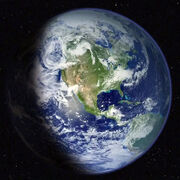m (→Background: eplinks) |
HighwindBot (talk | contribs) m (Robot: Cosmetic changes !!wikia-credits fix!!) |
||
| Line 1: | Line 1: | ||
| − | [[ |
+ | [[Image:earth.jpg|thumb|The Minshara Class planet Earth.]] |
In [[planetary classification]], a '''Class M''' (known as the '''Minshara class''' in the mid-22nd century among [[Vulcan]]s) [[planet]] or [[planetoid]] that is characterized by an abundance of surface [[water]] and an [[atmosphere]] high in [[nitrogen]] with [[oxygen]] and trace [[element]]s. [[Life]] is often abundant on Class M planets; they contain extensive vegetation, animal life and often have native [[humanoid]]s. |
In [[planetary classification]], a '''Class M''' (known as the '''Minshara class''' in the mid-22nd century among [[Vulcan]]s) [[planet]] or [[planetoid]] that is characterized by an abundance of surface [[water]] and an [[atmosphere]] high in [[nitrogen]] with [[oxygen]] and trace [[element]]s. [[Life]] is often abundant on Class M planets; they contain extensive vegetation, animal life and often have native [[humanoid]]s. |
||
| Line 13: | Line 13: | ||
Vulcan does not have an abundance of water, yet is deemed Class M. {{incite}} |
Vulcan does not have an abundance of water, yet is deemed Class M. {{incite}} |
||
| − | According to the ''[[Star Trek Star Charts]]'', class M planets have an age that ranges from 3-10 billion years and a diameter between 10,000 and 15,000 km. They are located within the Ecosphere of a [[star system]]. |
+ | According to the ''[[Star Trek Star Charts]]'', class M planets have an age that ranges from 3-10 billion years and a diameter between 10,000 and 15,000 km. They are located within the Ecosphere of a [[star system]]. |
[[Category:Astronomical objects]] |
[[Category:Astronomical objects]] |
||
Revision as of 22:17, 20 March 2008

The Minshara Class planet Earth.
In planetary classification, a Class M (known as the Minshara class in the mid-22nd century among Vulcans) planet or planetoid that is characterized by an abundance of surface water and an atmosphere high in nitrogen with oxygen and trace elements. Life is often abundant on Class M planets; they contain extensive vegetation, animal life and often have native humanoids.
Examples of Class M planets include: Earth, Vulcan, Cardassia Prime, Bajor, Romulus, Ferenginar, and Qo'noS.
| Planetary classification |
|---|
| B • D • G • H • J • K • L • M • N • R • T • Y • Other classes |
Background
The term "Class M" was first used in "The Cage" to describe planet Talos IV.
Spock called the planet from TOS: "Return to Tomorrow" Class M despite the atmosphere being ripped away, suggesting that Class M goes beyond being able to support life. Alternately, he could have been saying that the planet prior to losing its atmosphere would have been categorized as Class M.
Vulcan does not have an abundance of water, yet is deemed Class M. (citation needed • edit)
According to the Star Trek Star Charts, class M planets have an age that ranges from 3-10 billion years and a diameter between 10,000 and 15,000 km. They are located within the Ecosphere of a star system.
